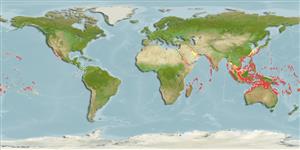>
Holocentriformes (Squirrelfishes, soldierfishes) >
Holocentridae (Squirrelfishes, soldierfishes) > Holocentrinae
Etymology: Sargocentron: Greek, sargos = sargus + Greek, kentron = sting (Ref. 45335).
Eponymy: Not an eponym, but apparently taken from a local name the describers encountered in Okinawa (the type locality). Itto means ‘the number one’ (i.e. the best of many). (Ref. 128868), visit book page.
More on authors: Jordan & Fowler.
Environment: milieu / climate zone / depth range / distribution range
Ecología
marino asociado a arrecife; rango de profundidad 5 - 190 m (Ref. 117152), usually 5 - 70 m (Ref. 9710). Tropical; 35°N - 24°S
Indo-Pacific: Red Sea and Natal, South Africa (Ref. 4201) to the Marquesan Islands, north to southern Japan and the Ogasawara Islands, south to New South Wales, Australia.
Tamaño / Peso / Age
Maturity: Lm ? range ? - ? cm
Max length : 20.0 cm TL macho / no sexado; (Ref. 9710)
Espinas dorsales (total) : 11; Radios blandos dorsales (total) : 13 - 14; Espinas anales: 4; Radios blandos anales: 8 - 10. Body with red and white stripes following the scale rows, the red stripes slightly narrower than the white ones (Ref. 4201) (red stripes usually broader for Taiwan and Japan specimens); lateral line scales for northern Philippines, Taiwan and Japan specimens 44-49; 5 oblique rows of scales on cheek; body depth 2.8-3.1 in SL; head length 2.8-3.1 in SL; short snout, 3.65-4.15 in head length; interorbital width 4.3-4.65 in head length; maxilla extending from below front of pupil to below center of eye, upper jaw length 2.6-2.9 in head length; premaxillary groove reaching about a vertical at anterior edge of orbit; rounded anterior end of nasal bone; edge of small nasal fossa without spine; median edge of nasal bone (premaxillary groove margin) without spinule; upper edge of suborbital bones below the eye weakly serrated and without lateral spine; short preopercular spine, about 1/3 orbit diameter, 5.5-8.2 in head diameter; 4th or 5th longest dorsal spines, 1.7-2.2 in head length; third anal spine long, 1.15-1.4 in head length (Ref. 27370).
Occurs in outer reef slopes. A nocturnal species that feeds mainly on benthic crabs and shrimps. Spine of preopercle venomous. Solitary or in groups (Ref 90102).
Life cycle and mating behavior
Madurez | Reproducción | Puesta | Huevos | Fecundidad | Larva
Randall, J.E., 1998. Revision of the Indo-Pacific squirrelfishes (Beryciformes: Holocentridae: Holocentrinae) of the genus Sargocentron, with descriptions of four new species. Indo-Pac. Fish. (27):105 p. (Ref. 27370)
IUCN Red List Status (Ref. 130435: Version 2024-2)
Human uses
Herramientas
Special reports
Download XML
Fuentes de Internet
Estimates based on models
Preferred temperature (Ref.
123201): 24.7 - 29, mean 27.9 °C (based on 632 cells).
Phylogenetic diversity index (Ref.
82804): PD
50 = 0.5000 [Uniqueness, from 0.5 = low to 2.0 = high].
Bayesian length-weight: a=0.01660 (0.00788 - 0.03495), b=2.97 (2.80 - 3.14), in cm total length, based on LWR estimates for this Genus-body shape (Ref.
93245).
Nivel trófico (Ref.
69278): 3.6 ±0.60 se; based on food items.
Resiliencia (Ref.
120179): Alto, población duplicada en un tiempo mínimo inferior a 15 meses (Preliminary K or Fecundity.).
Fishing Vulnerability (Ref.
59153): Low vulnerability (10 of 100).
Nutrients (Ref.
124155): Calcium = 60.9 [24.0, 255.4] mg/100g; Iron = 0.549 [0.221, 1.663] mg/100g; Protein = 18.5 [17.3, 19.7] %; Omega3 = 0.178 [0.076, 0.408] g/100g; Selenium = 43.6 [25.1, 83.3] μg/100g; VitaminA = 72.8 [28.2, 199.8] μg/100g; Zinc = 1.86 [0.77, 3.47] mg/100g (wet weight);
